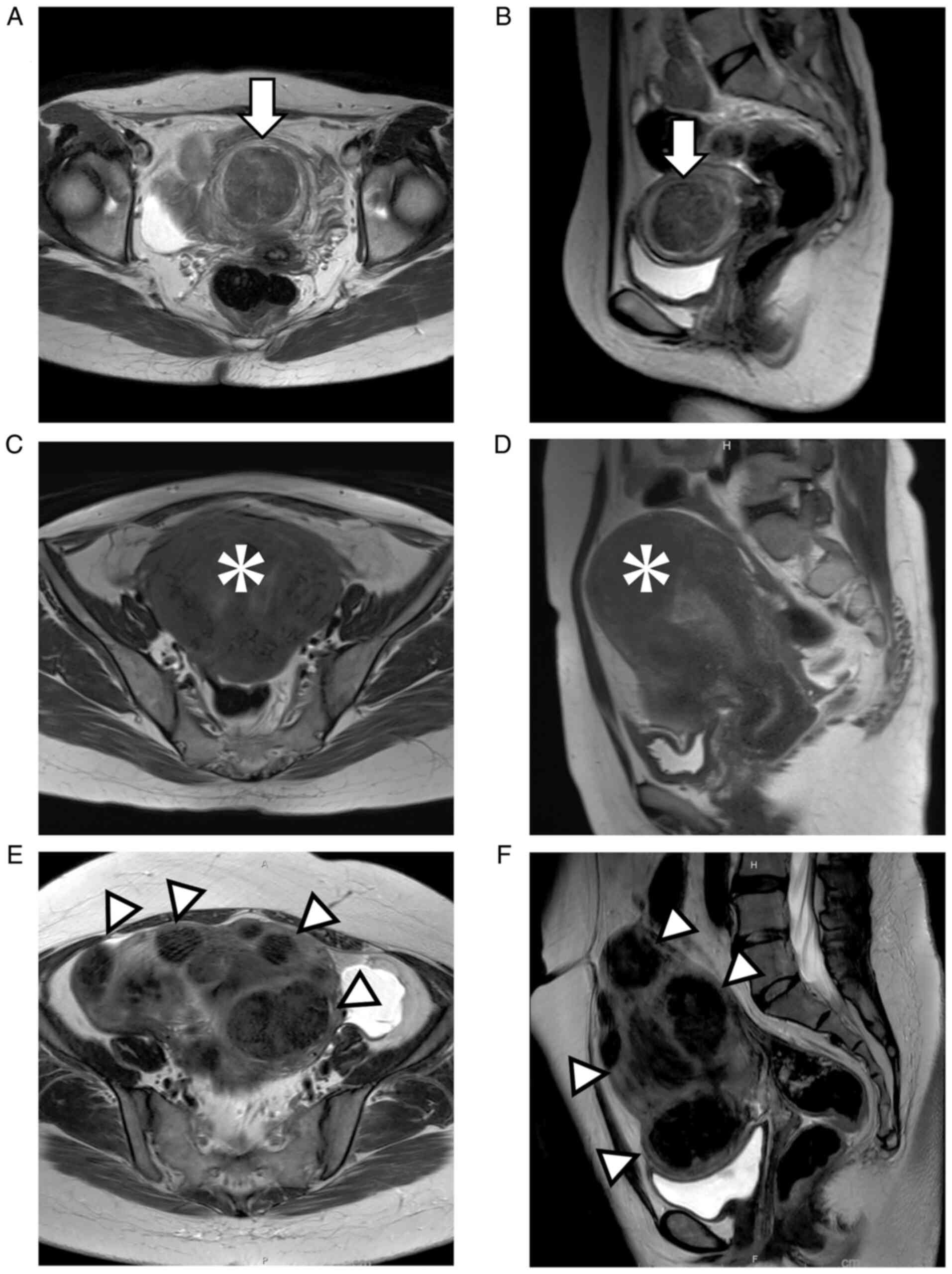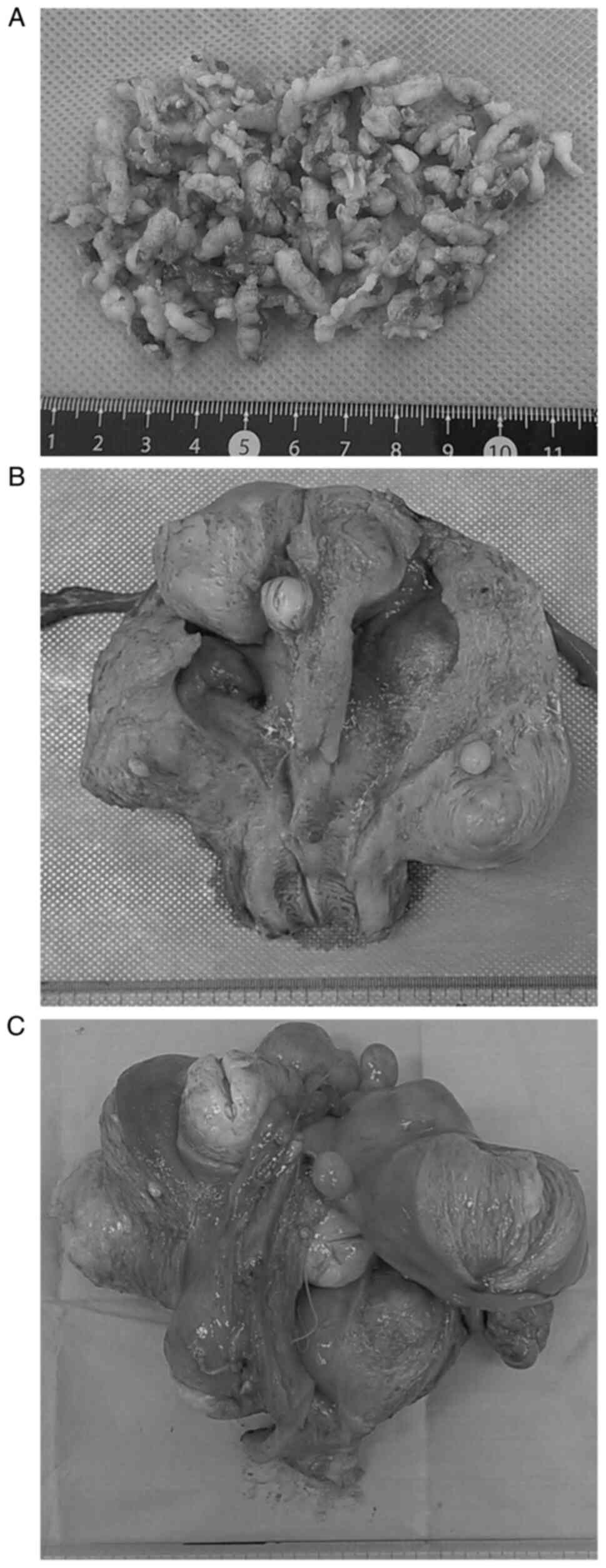|
1
|
Stewart EA, Cookson CL, Gandolfo RA and
Schulze-Rath R: Epidemiology of uterine fibroids: A systematic
review. BJOG. 124:1501–1512. 2017.PubMed/NCBI View Article : Google Scholar
|
|
2
|
Manyonda I, Belli AM, Lumsden MA, Moss J,
McKinnon W, Middleton LJ, Cheed V, Wu O, Sirkeci F, Daniels JP, et
al: Uterine-artery embolization or myomectomy for uterine fibroids.
N Engl J Med. 383:440–451. 2020.PubMed/NCBI View Article : Google Scholar
|
|
3
|
Edwards RD, Moss JG, Lumsden MA, Wu O,
Murray LS, Twaddle S and Murray GD: Committee of the Randomized
Trial of Embolization versus Surgical Treatment for Fibroids.
Uterine-artery embolization versus surgery for symptomatic uterine
fibroids. N Engl J Med. 356:360–370. 2007.PubMed/NCBI View Article : Google Scholar
|
|
4
|
Hehenkamp WJ, Volkers NA, Birnie E,
Reekers JA and Ankum WM: Symptomatic uterine fibroids: Treatment
with uterine artery embolization or hysterectomy-results from the
randomized clinical Embolisation versus hysterectomy (EMMY) Trial.
Radiology. 246:823–832. 2008.PubMed/NCBI View Article : Google Scholar
|
|
5
|
Donnez J and Dolmans MM: Uterine fibroid
management: From the present to the future. Hum Reprod Update.
6:665–686. 2016.PubMed/NCBI View Article : Google Scholar
|
|
6
|
Institute for Health Metrics and
Evaluation. Uterine Fibroids - Level 4 Cause. https://www.healthdata.org/results/gbd_summaries/2019/uterine-fibroids-level-4-cause.
Accessed July 10, 2022.
|
|
7
|
Suthar AB, Wang J, Seffren V, Wiegand RE,
Griffing S and Zell E: Public health impact of covid-19 vaccines in
the US: Observational study. BMJ. 377(e069317)2022.PubMed/NCBI View Article : Google Scholar
|
|
8
|
Yano M, Katoh T, Nakajima Y, Iwanaga S,
Kin R, Kozawa E and Yasuda M: Uterine intravenous leiomyomatosis
with an isolated large metastasis to the right atrium: A case
report. Diagn Pathol. 15(4)2020.PubMed/NCBI View Article : Google Scholar
|
|
9
|
Chai AL, Huang OY, Rakočević R and Chung
P: Critical iron deficiency anemia with record low hemoglobin: A
case report. J Med Case Rep. 15(472)2021.PubMed/NCBI View Article : Google Scholar
|
|
10
|
Teasdale G and Jennett B: Assessment of
coma and impaired consciousness. A practical scale. Lancet.
2:81–84. 1974.PubMed/NCBI View Article : Google Scholar
|
|
11
|
Can Ç, Gulacti U and Kurtoglu E: An
extremely low hemoglobin level due to menorrhagia and iron
deficiency anemia in a patient with mental retardation. Int Med J.
20:735–736. 2013.
|
|
12
|
Jost PJ, Stengel SM, Huber W, Sarbia M,
Peschel C and Duyster J: Very severe iron-deficiency anemia in a
patient with celiac disease and bulimia nervosa: A case report. Int
J Hematol. 82:310–311. 2005.PubMed/NCBI View Article : Google Scholar
|
|
13
|
Klutstein MW and Tzivoni D: Anaemia and
heart failure: Aetiology and treatment. Nephrol Dial Transplant. 20
(Suppl 7):vii7–vii10. 2005.PubMed/NCBI View Article : Google Scholar
|
|
14
|
Tobian AA, Ness PM, Noveck H and Carson
JL: Time course and etiology of death in patients with severe
anemia. Transfusion. 49:1395–1399. 2009.PubMed/NCBI View Article : Google Scholar
|
|
15
|
Shin DW, Lee JW, Jung JH, Han K, Kim SY,
Choi KS and Park JH and Park JH: Disparities in cervical cancer
screening among women with disabilities: A national database study
in South Korea. J Clin Oncol. 36:2778–2786. 2018.PubMed/NCBI View Article : Google Scholar
|
|
16
|
Shinden Y, Kijima Y, Hirata M, Nakajo A,
Tanoue K, Arigami T, Kurahara H, Maemura K and Natsugoe S: Clinical
characteristics of breast cancer patients with mental disorders.
Breast. 36:39–43. 2017.PubMed/NCBI View Article : Google Scholar
|
|
17
|
Willis D, Samalin E and Satgé D:
Colorectal cancer in people with intellectual disabilities.
Oncology. 95:323–336. 2018.PubMed/NCBI View Article : Google Scholar
|
|
18
|
Sato F, Mori M, Nishi M, Kudo R and Miyake
H: Familial aggregation of uterine myomas in Japanese women. J
Epidemiol. 12:249–253. 2002.PubMed/NCBI View Article : Google Scholar
|
|
19
|
Critchley HOD, Babayev E, Bulun SE, Clark
S, Garcia-Grau I, Gregersen PK, Kilcoyne A, Kim JJ, Lavender M,
Marsh EE, et al: Menstruation: Science and society. Am J Obstet
Gynecol. 223:624–664. 2020.PubMed/NCBI View Article : Google Scholar
|
















